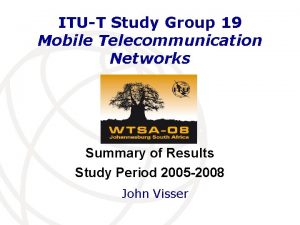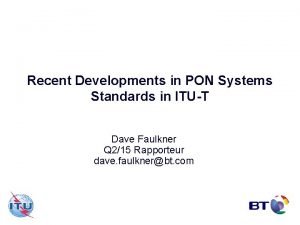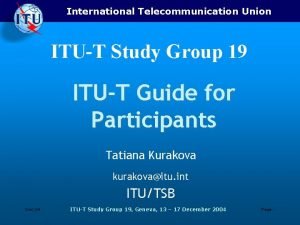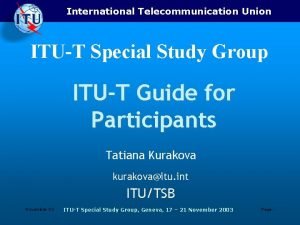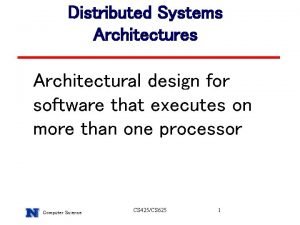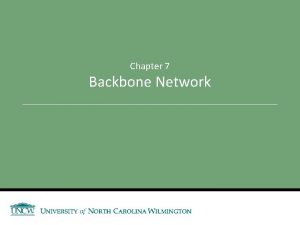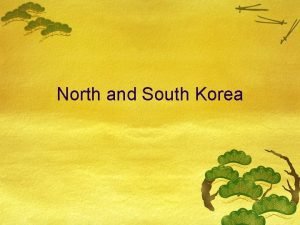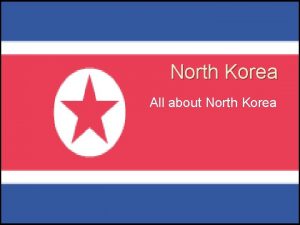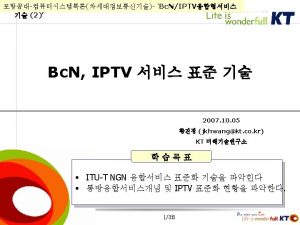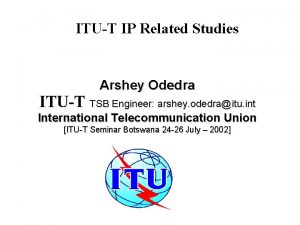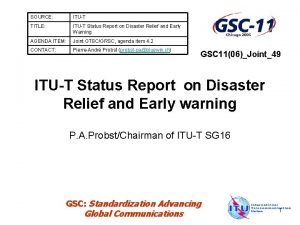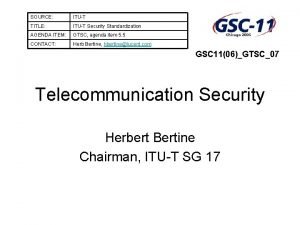Korea Telecom Architectures Interworking in ITUT SG 13


















- Slides: 18

Korea Telecom Architectures & Interworking in ITU-T SG 13 14 May 2001 Chae-Sub, LEE (Korea Telecom) 1

Korea Telecom Contents • • • Scope of WP 2/13 Questions in WP 2/13 Future Evolution Trend Role & Activities of WP 2/13 study Vision of WP 2/13 2

Korea Telecom 1. Scope of WP 2/13 ARCHITECTURE GII 64 kbps based ISDN ATM/BISDN IP based network Multi-Protocol based network NGN INTERWORKING 3

Korea Telecom Scope and impacts of Architecture Work • PC based Multimedia • Mobile communication • Home/Personal video • Netizen Service requirements and its Provision To. P Down Long Term • Principles • Identification of Resources • Assignment to Functional Group • Identification of Reference Points • Specifying required Capabilities • Business Model • Logical Model / Framework Architecture Work • Functional Model • Implementational Model • Specification of capabilities • Scenarios • Router/switch • Soft switch • wireless access, x. DSL/WDM Facility Network Bottom Up Short Term 4

2. Questions in WP 2/13 Korea Telecom Question Title 1/13 Principles, Requirements, Frameworks and Architectures for an Overall Heterogeneous Network Environment 5/13 Network Interworking including IP Multiservice Networks 10/13 Core Network Architecture and Interworking Principles 13/13 Interoperability of Satellite and Terrestrial Networks 14/13 Access Architecture Principles and Features at the Lower Layers for IP-Based and Other Systems 16/13 Telecommunication Architecture for an Evolving Environment 5

2. Future Evolution Trend Korea Telecom Change of Environment Full Open and Competition Environments Telecom. Business Broadcasting Business Data inc. Data Voice Integrated Service Voice Tele-Broadcasting Business End to End Client to Server User friendly control Circuit based Packet based transport Electronic based Optic based transmission Integrated Telecommunication Infrastructure 6

Korea Telecom Market Changes and its Push Circuit based Penetration (%) 50 Packet over 40 Circuit 30 20 Packet based 10 Circuit over Packet 1996 1997 1998 1999 2000 2001 2002 2003 Fixed telephone service Cellular & PCS Internet service users 7

Korea Telecom Expected Future Transition Trend Past : Seper. of Voice & Data Transp. Circuit Switch. Access Capa. Circuit Switch. Transp. Capa. Packet Switch. Transp. Capa. Present : Sep. of V & D Access Circuit Switch. Access Capa. Packet Switch. Access Capa. Circuit Switch. Transp. Capa. Packet Switch. Transp. Capa. x. DSL / FTTx Future : Integration of V & D Access and Transp. Near Future : Integration of V & D Transport Circuit Switch. Access Capa. Packet Switch. Transp. Capa. Packet Switch. Access Capa. Circuit Switch. Transp. Capa. Packet Switch. Transp. Capa. Vo. IP / VTo. A 8

Korea Telecom Server based Configuration Service / Application 1 Service / Application 2 Service / Application 3 Naming Policy Server Subscrib. Server Net. B Net. C Service / Application 4 Service / Application 3 Net. A Service / Application 4 Feature Server Resource Server (Middleware) Network Net. D Connectivity Network 9

Korea Telecom Extension of Core Network Functions Traffic Policing Brokering Switching Transmission Past Switching Routing Media Adaptation Switching Resource Arranging Brokering Routing Transmission Today Near Future 10

Korea Telecom Diversity of Access Technologies Management Platform - CMIP - SNMP - JAVA - CORBA - DCOM Network Management Accessing Addressing - ISDN - ADSL - IPv 4, v 6 - Cable Modem - E. 164 - FLC - NSAP - FTTH Policing Switching & Routing - IP - MPLS - ATM Routing Multiplexing - IP - ATM - F/R - SDH/PDH - WDM Backbone Switching Network Transmission - ATM - SDH - WDM Switching Access Network Access Switching Network Backbone Transmission Network Policing 11

Korea Telecom Possible Convergence Model of Tele-Broadcasting Regulator Program User Operator Provider Relations Enterprise Model Regulation New Applications and their Service Interworking Networking Technologies and their Adaptations Interworking between two Infrastructures and their convergence New Technologies and their Products Telegaming EComm. Interac. TV Web TV/FM TV Mail TV Internet IP Platform or Others Broadcasting Infra. Telec. Infra. Computer/Consumer Technologies Structural Model of Convergence 12

Korea Telecom 4. Role and Activities of WP 2/13 Study Interconnection • Develop Framework Architecture for RPOI • Identify Reference Point of Interconnection • Specify Attributes and Requirements of RPOI Architecture • Framework Architecture of GII and Principle • Develop Telecom. Archit. For Evolv. Environ. • Study of New Reference Model • Develop Framework of IP based Network • Develop Automatic Transport Net. Archit. • Develop Access Network Architecture • Specify Network Capabilities for IP and others Interworking • Develop Framework for Interworking • Specify Interworking Functions btw. Different Networks and Services 13

Framework for RPOIs (Refer Rec. Y. 140) Korea Telecom 14

Korea Telecom Information Communication Architecture (Rec. Y. 130) • identify the functions and behaviors between the user and network facilities in terms of middleware services ; • ensure adequate de-coupling between end user and network technologies; • define functions and behavior of middleware components; • identify points at which open interfaces might be defined. Party Identification Session Management Transport Selection 15

Korea Telecom Work plan of Automatic Switched Transport Network Consent at this May SG 13 Meeting G. astn ASTN Architecture Discovery Signaling Routing ASTN Control Plane CAC Link Restoration management Transport G. ason G. ndisc G. sdisc G. dcm Modified existing or G. otnrtg G. otncac G. otnlm Modified existing or G. otnres G. 959. 1/ G. 709/G. 798/ G. dcn/etc Consent at this October SG 15 Meeting 16

Korea Telecom Interworking between Telecom Networks and IP based Network Ref. Rec. Y. 1401 • Transport Plane Interworking • Control Plane Interworking • Management Plane Interworking 17

5. Vision of WP 2/13 Pack sed et ba inf Korea Telecom ure t c u r rast es su IP Is • Application of IP technology into Telecom infra and • specify Interworking between IP and Telecom service/network • New architecture for full Packet based infrastructure (inc. Voice) • Migration path from Circuit based to Packet based infra (inc. Interworking) • Service and network capabilities for providing Packet based services • New access technology, OAM and Performance study based on full Packet infra 18
 Itut
Itut Cabs.itut
Cabs.itut Study group union
Study group union Cabs itut
Cabs itut Itut
Itut Gpu cache coherence
Gpu cache coherence Database system architectures
Database system architectures Database and storage architectures
Database and storage architectures E business architecture
E business architecture George schlossnagle
George schlossnagle Why systolic architectures
Why systolic architectures Aaron bannert
Aaron bannert Cdn architectures
Cdn architectures Base system architectures
Base system architectures Distributed systems architectures
Distributed systems architectures Integral product architecture
Integral product architecture 2 tier data warehouse architecture
2 tier data warehouse architecture Switched backbone networks
Switched backbone networks Backbone network architectures
Backbone network architectures
